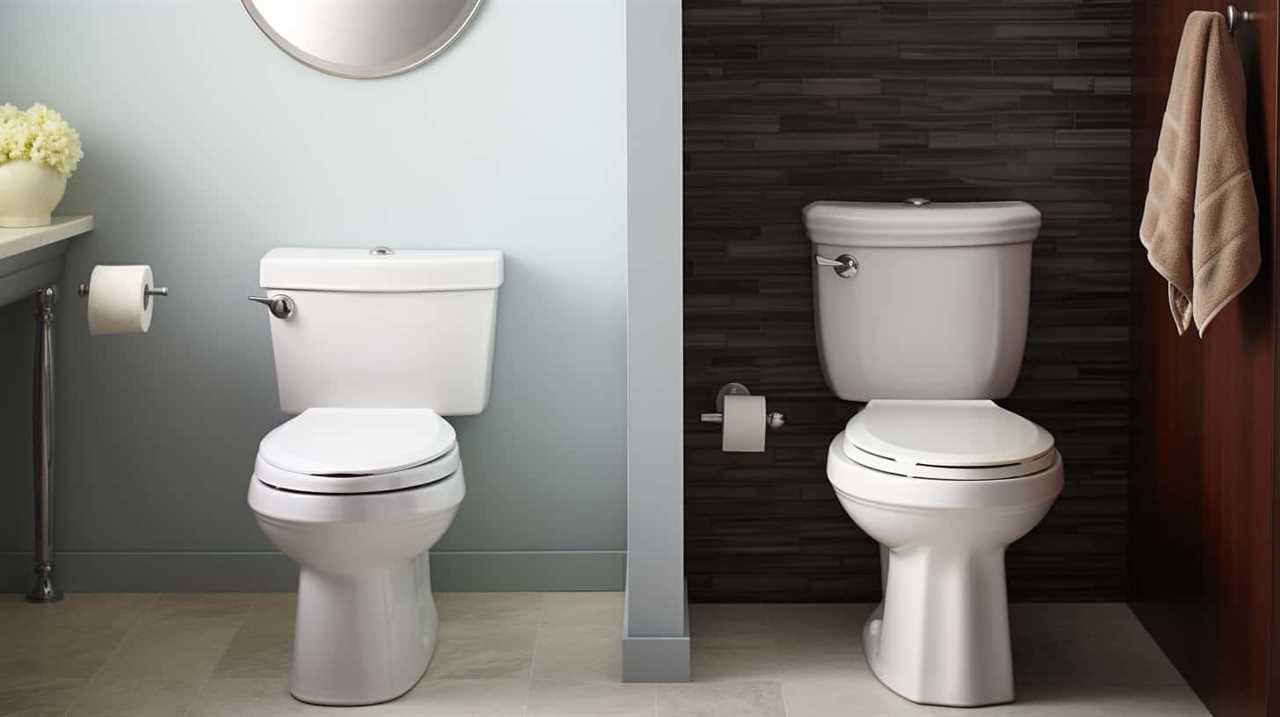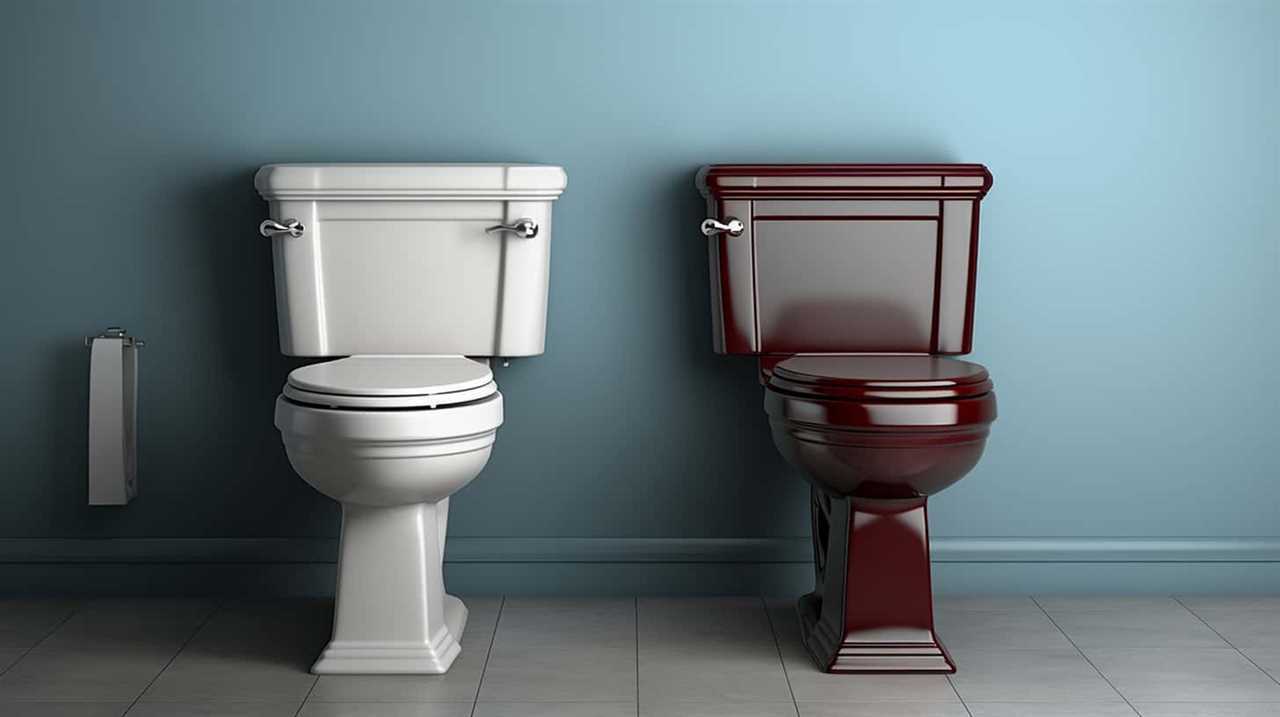Did you know that nearly 60% of people experience their leg falling asleep while on the toilet? It can be an uncomfortable and puzzling sensation, but understanding why it happens is crucial.
In this article, I will explore the anatomy of the leg and the nerves involved, as well as the factors that contribute to leg numbness and tingling on the toilet. By understanding the mechanisms at play, we can learn how to prevent this common occurrence and when to seek medical attention if necessary.
Key Takeaways
- Leg falling asleep on the toilet is usually caused by nerve compression and reduced blood flow.
- Prolonged sitting, poor posture, and lack of movement contribute to leg discomfort and numbness.
- Proper posture, such as keeping the feet flat on the ground and the knees at a 90-degree angle, can alleviate leg numbness by promoting blood flow and reducing nerve compression.
- Regular physical activity, stretching exercises, and taking breaks from sitting can improve circulation and prevent leg discomfort on the toilet.
The Anatomy of the Leg and Nerves Involved
When you sit on the toilet for a long time, the pressure can compress the nerves in your leg, causing it to fall asleep. This mechanism of leg numbness occurs due to nerve compression and tingling.
To understand this phenomenon, it’s important to know the anatomy of the leg and the nerves involved. The leg consists of various muscles, bones, and blood vessels, all connected by a complex network of nerves. The main nerve responsible for leg sensation is the sciatic nerve, which originates in the lower back and runs down the back of the leg.
When pressure is applied to the leg for an extended period, it can compress the sciatic nerve, leading to reduced blood flow and impaired nerve signaling. This compression can result in the tingling sensation and temporary loss of feeling commonly experienced when the leg falls asleep on the toilet.
Understanding the Mechanism of Sleepy Legs on the Toilet
While sitting on the toilet, you might experience a sensation of your leg going numb. This phenomenon occurs due to the mechanism of leg numbness, which involves compression or irritation of the nerves in the leg.
When you sit for an extended period, the pressure exerted on the nerves can disrupt their normal function, leading to tingling or numbness.
The causes of leg tingling on the toilet can vary, including prolonged sitting, poor posture, and reduced blood flow to the leg. Additionally, factors such as obesity, nerve damage, and certain medical conditions can contribute to this uncomfortable sensation.
Understanding the mechanism and causes of leg numbness and tingling on the toilet is crucial in finding ways to prevent and alleviate this issue.
Factors Contributing to Leg Numbness and Tingling on the Toilet
To prevent leg numbness and tingling while sitting on the toilet, you should avoid prolonged periods of sitting and maintain good posture. There are several factors that can contribute to leg discomfort on the toilet. These include poor circulation, nerve compression, and lack of movement.
Poor circulation occurs when you sit for long periods of time, restricting blood flow to the legs and leading to numbness and tingling. Nerve compression can occur when you sit with improper posture, putting pressure on the nerves in the legs and causing discomfort. Lack of movement also contributes to leg numbness.
To alleviate leg numbness and tingling, you can try the following remedies. Take breaks and stand up to stretch your legs every few minutes to improve circulation. Adjust your posture by sitting with your feet flat on the floor and your back straight to relieve nerve compression. Engaging in regular physical activity can also improve circulation and prevent leg discomfort.
How Posture Affects Blood Flow and Nerve Compression on the Toilet
Maintaining proper posture while sitting on the toilet can improve blood flow to the legs and alleviate nerve compression. When we sit on the toilet, our legs can sometimes fall asleep due to decreased blood circulation and nerve compression. By sitting with our feet flat on the ground and our knees at a 90-degree angle, we can help promote better blood flow to the legs. This posture prevents the blood vessels from being constricted, allowing for a more efficient circulation.
Additionally, keeping our spine straight and avoiding hunching over can help alleviate nerve compression. This ensures that the nerves in our lower back and legs are not being compressed, reducing the chances of experiencing numbness or tingling.
However, certain medical conditions can also contribute to legs falling asleep on the toilet.
Medical Conditions That Can Cause Legs to Fall Asleep on the Toilet
When it comes to experiencing the sensation of a leg falling asleep on the toilet, there are several key points to consider.
First, nerve compression and tingling can occur when there is pressure on the nerves in the legs, leading to temporary loss of sensation.
Second, poor circulation can contribute to numbness in the legs, as blood flow may be restricted in certain positions.
Nerve Compression and Tingling
The sensation of a leg falling asleep on the toilet is often caused by nerve compression. When we sit on the toilet for too long, the pressure from our body weight can compress the nerves in our legs, leading to temporary loss of sensation. This can be quite uncomfortable and even alarming, but it is usually harmless and resolves on its own once we change our position.
However, in some cases, repeated nerve compression can lead to more serious issues such as nerve damage or chronic sensation loss. It is important to be mindful of how long we spend on the toilet and take breaks to prevent prolonged pressure on our nerves.
Remember, our nerves play a crucial role in our body’s functioning, and taking care of them is essential for our overall well-being.
- Prolonged pressure on nerves can cause temporary loss of sensation.
- Repeated nerve compression can lead to nerve damage.
- Chronic sensation loss can result from improper care of our nerves.
Poor Circulation and Numbness
To improve poor circulation and prevent numbness, it is important to regularly move and stretch your legs throughout the day. Poor circulation can be caused by various factors, such as a sedentary lifestyle, obesity, smoking, and certain medical conditions like diabetes or peripheral artery disease. When blood flow is restricted, it can lead to leg numbness and tingling.
Remedies for poor circulation include regular exercise, maintaining a healthy weight, quitting smoking, and wearing compression stockings. These measures help to improve blood flow and alleviate numbness in the legs. Additionally, incorporating foods rich in antioxidants and omega-3 fatty acids into your diet can also promote circulation.
By taking proactive steps to improve circulation, you can reduce the risk of leg numbness and maintain overall health.
As we transition into the subsequent section about posture and muscle strain, it’s important to note that these factors can also contribute to leg numbness and poor circulation.
Posture and Muscle Strain
When it comes to leg numbness on the toilet, there are some common misconceptions that I’d like to address.
First, many people believe that sitting on the toilet for too long can cause leg numbness. However, the real culprit is often poor posture. Sitting with your legs crossed or putting too much pressure on the nerves in your legs can lead to numbness and tingling.
Another misconception is that dehydration is the main cause of leg numbness on the toilet. While hydration is important for overall health, it may not directly prevent leg numbness. However, staying properly hydrated can help maintain healthy blood flow and reduce the risk of muscle cramps.
In the next section, I will discuss some helpful tips to prevent leg numbness and tingling while using the toilet.
Tips to Prevent Leg Numbness and Tingling While Using the Toilet
Try adjusting your sitting position on the toilet to prevent leg numbness and tingling. To maintain a proper seating position, make sure your feet are flat on the floor and your knees are slightly higher than your hips. This helps to promote better blood circulation and prevents compression of nerves in your legs.
Additionally, incorporating stretching exercises into your daily routine can help alleviate leg discomfort. Simple stretches like ankle circles, calf raises, and knee-to-chest stretches can improve flexibility and reduce the risk of numbness and tingling.
Remember to take breaks and avoid sitting on the toilet for prolonged periods.
When to Seek Medical Attention for Persistent Leg Symptoms on the Toilet
When experiencing persistent leg symptoms while using the toilet, it is important to seek medical attention. While some leg numbness and tingling may be temporary and easily resolved, persistent symptoms could be indicative of an underlying medical condition that requires treatment. Here are some reasons why seeking medical attention is necessary:
-
Nerve Compression: Prolonged compression of nerves can lead to chronic leg symptoms, such as numbness and tingling.
-
Circulatory Issues: Reduced blood flow to the legs can cause persistent symptoms that should not be ignored.
-
Nerve Damage: Long-term nerve damage can result in ongoing leg discomfort and should be evaluated by a medical professional.
Frequently Asked Questions
How Long Does It Usually Take for the Leg to Fall Asleep on the Toilet?
It usually takes a few minutes for my leg to fall asleep on the toilet. I think it has to do with the design of the toilet seat and how it may affect blood circulation.
Can Sitting on a Different Type of Toilet Seat Prevent Leg Numbness and Tingling?
Sitting on a different type of toilet seat can prevent leg numbness and tingling. Squatting, for example, has been shown to improve blood flow and reduce pressure on nerves. So, trying toilet seat alternatives like squatting may provide benefits.
Is Leg Numbness and Tingling on the Toilet a Sign of a Serious Medical Condition?
Leg numbness and tingling on the toilet is usually not a sign of a serious medical condition. It is often caused by prolonged pressure on the nerves. Changing sitting posture and using a cushion may help alleviate symptoms.
Are There Any Exercises or Stretches That Can Help Prevent Leg Numbness and Tingling While Using the Toilet?
Exercises and stretches can help prevent leg numbness and tingling on the toilet. By incorporating gentle movements and stretches into your routine, you can improve circulation and reduce the likelihood of your leg falling asleep.
What Are the Potential Long-Term Effects of Experiencing Leg Numbness and Tingling on the Toilet?
The potential long-term effects of leg numbness and tingling on the toilet can include nerve damage, reduced mobility, and chronic pain. Remedies such as changing positions, stretching, and taking breaks can help prevent these issues.
Conclusion
In conclusion, the sensation of our leg falling asleep on the toilet can be attributed to various factors. These include nerve compression, poor posture, and underlying medical conditions. It is important to maintain good posture and take breaks to avoid prolonged pressure on the nerves.
Interestingly, studies have shown that approximately 60% of people experience leg numbness and tingling while using the toilet. By being aware of these factors and implementing preventive measures, we can minimize the discomfort and prevent further complications.










